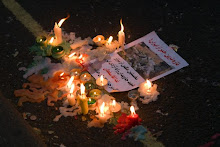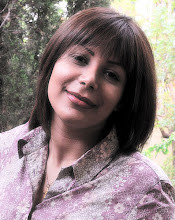Say, what? ---
I was puzzled by the title too but, undaunted, high-tailed it off to Aberdeen, gorgeous, graceful, granite-grey city, glistening sea-side, stately trees and rushing, shining river, bright winter sun and magnificent (eat yer heart out Cambridge and Oxford), magnificent university campus, and had a whale of a time at the conference above named.
What's in the Name?
First things first, why Ending? It’s all in the question mark, of course. It seems that some feminist academics are engaged in one of those quasi-apocalyptic moments, a bit like the art world gets into about every ten years or so, when a bunch of people produce manifestos or articles or similar saying ‘the end of art?’(craft/global capitalism/ celebrity/ religion/ life/ the universe – delete as applicable), and organise endless conferences, seminars, happenings, etc to discuss the matter and generally create much carbon emission.
'Hell No!'
So, I added my carbon footprint to everyone else’s and went and said, ‘hell no,’ along with all the other speakers and everyone there who said, ‘hell no’ too. This was in fact the last of four conferences, which, I now suspect, were convened chiefly to say a monumental collective, ‘hell no’ very loudly. And we did. There certainly wasn’t any sign of feminism ending, quite the contrary; there were a great many new beginnings, much growing of small, feminist bean sprouts. Oh and some splendid making of cheese cakes.
'So then what happened?'
The genesis of the four workshops/conferences was something to do with International Relations, although this conference was hosted by Marysia Zalewski and the University of Aberdeen’s Centre for Gender Studies and School of Social Science. There was an IR tinge to most of the papers, but not all. It was admirably varied, quite a bit of cultural studies, some media studies, a very cool genomics meets eco feminism via science fiction joint paper, a study of how women were pictured by Communist Poland and then by the Solidarity movement ‘women tractor drivers to Solidarity women’, I talked about Shattered. Actually, I talked about Traffic, which is one the pots in Shattered, (see website), and there were several papers which were either about trafficking or touched on it somewhere. A Dutch woman talked about feminist Egyptian (documentary) Cinema, (that one was really fascinating,) a Turkish woman, talked about the construction of Turkish masculinity through compulsory military service, also fascinating. Cynthia Enloe talked about post-war Iraq and post-wars going back to the First World War and how feminists need to intervene in these situations and in how the stories are told. She produced the quote of the conference in my estimation: ‘Widows make people very nervous.’ Too bloody right they do, you should see what they’re doing in Iran.
'And What Else?'
Some papers were very esoteric, exploring much chewy, involved, quite abstract theory, others were more like discussions of a much bigger research project. It provided an immensely diverse overview of feminism at work in the academy and of feminists, in every imaginable discipline, bringing their feminism to scrutinise and - in the case of IR in particular – almost reinvent it. One of the most imaginative and highly successful strands to this event was the part played by artists and some students from Gray’s School of Art, who curated a show of their work. An artist called Merlyn Riggs was doing participatory work. We all had to bring something which was indicative of us and she photographed the things for 'The Museum of Me'. She introduced the work saying, 'My work is about 'Me, Meals, and Menopause,' -(she was responsible for the cheescake recipes). She's also been working with women in a drop in centre and with women in the Sottish Parliament. Alex Brew, another of the artists, has been working with images of men,'Why don't women objectify men?' she asked. She's written an excellent piece for The F Word which is linked to her website, here.
Mixing It Up
It would be truly revolutionary to see planets art, craft and, especially, ceramics, following suit. Unfortunately ‘interdisciplinary’ on planet craft just means including different media, for example textile art mixing with digital media, which you might think was part of how textile/fibre art was developing in digital times anyway, but apparently this counts as interdisciplinary. Not in my book it doesn’t. That’s just visual art behaving as it should. The Crafts Council is consulting on good practice in the crafts, fostering ambition, that sort of thing. I’d suggest this was an excellent example of good practice I’d like to see imported into craft practices.
'Now What?'
Conferences are an extraordinary opportunity to listen to things we don’t normally listen to and meet people we wouldn’t normally meet, this one particularly so because of its interdisciplinary element. Academic departments are often entirely separate from one another, even within a single university, which limits the spread of knowledge because people can’t easily learn from each other. A truly interdisciplinary event such as this can capitalise on the broad dissemination of research which results from the mix and make a real contribution to the building and sustaining of knowledge in that it brings new ways of understanding the issues that arise within our own disciplines. I want to encourage the visual arts and craft institutions that I’m involved with to be much more interdisciplinary in their approach particularly to the dissemination of our work and research. Neither academia nor the art/craft world are particularly well disposed to this kind of interdisciplinary high-jinks, and this conference was an object lesson in how to do it.
Sunday, 2 November 2008
Subscribe to:
Comments (Atom)











































